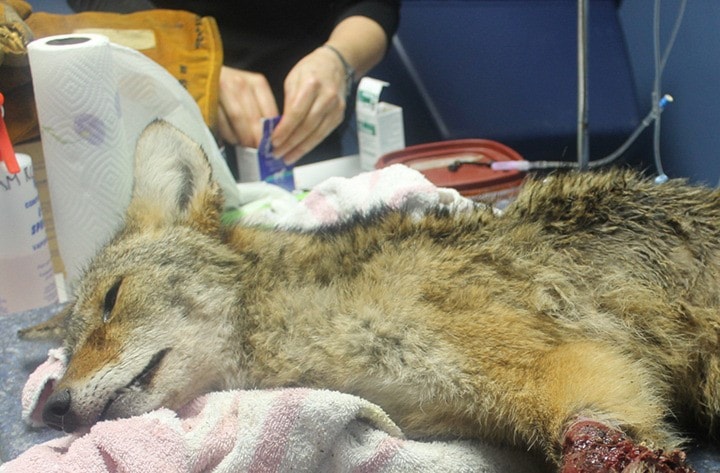A gruesome discovery in Abbotsford on Saturday has an animal rights group demanding changes.
On March 2, a local couple discovered a coyote with its leg in a leg-hold trap caught in some branches in a wooded area of Beaton Road.
Critter Care Wildlife Society (CCWS) of Langley was contacted. However, due to the severity of its mangled leg, the one- to two-year-old coyote had to be euthanized,
Now the Association for the Protection of Fur-Bearing Animals is reiterating its call for reform on leg-hold trap laws in B.C. and asking the City of Abbotsford to stop any city-endorsed use of traps.
“It is time for the government of British Columbia to recognize the lack of accountability and integrity in the trapping business,” said Lesley Fox, executive director of the Association for the Protection of Fur-Bearing Animals.
“These traps are being set in areas that are known to be frequented by families – including small children and pets – with no signage or warnings. These traps are not being monitored or set as required by law. These traps are causing incredible suffering daily and there is no justifiable excuse for allowing it to continue.”
According to Fox, trapping occurs in B.C. more often than people realize, especially in the Fraser Valley, and some of it is endorsed by municipal governments.
“Abbotsford, to the best of our knowledge, uses beaver traps. There’s quite a bit of beaver trapping that happens.”
While they don’t use leg-hold traps, Fox said the use of Conibear traps is equally disturbing. Those are designed to break an animal’s neck, or spine, and are not humane. She also noted that last year at least 10 dogs in the Lower Mainland were caught in Conibear traps.
Jim Gordon, the city’s general manager of engineering and regional utilities said the city doesn’t perform any of its own trapping. It does, however, hire someone from time to time.
“In the past, and I’m thinking seven or eight years ago, we hired provincially licensed trappers to remove beavers from some streams where there was flooding,” he said.
While he was unaware if there had been any recent problems with beavers, Gordon said it was “safe to say” that if problems occurred “we’d do the same thing.” He also said the trap would have to be provincially approved.
Fox wants Abbotsford to be a leader in the fight against trapping.
“Abbotsford could pass a ban on municipal trapping, which they can do. They can prohibit the use of traps in their own district.
She said if the city took this action, her group would “come to Abbotsford for free and build you and train the city on how to replace beaver traps.”
Fox would like to see some changes to trapping regulations to increase accountability.
Her group would like to see traps require serial numbers or ID tags so owners could be identified.
They also want signage to be mandatory in areas that have traps. Fox said warning signs are crucial considering traps can be place as close as 300 metres from a dwelling.
And people have been caught in traps before.
In April 2002, a 13-year-old was playing in Abbotsford’s Picton Park and hopped the fence around the retention pond to have a look at the beaver dam. He became caught in a beaver trap and three men helped to free him.
A provincial ban on body-gripping traps is the ultimate goal for Fox, who said none of the devices are humane.
The Abbotsford trap, used to snare the coyote, is called a “padded” trap, but Fox said they are just as crippling.
Critter Care performed an examination of the coyote found in Abbotsford and determined that it had been stuck for at least two days, had chewed four to five centimetres into its own leg, the bone was broken and the wound was septic.
“That’s the padded trap,” said Fox.
The BC Trappers Association, located in Prince George, could not be reached for comment, but did issue a press release on Tuesday.
In it, the organization states that it would “like to express our disappointment that actions of this nature continue to occur.”
It continued to say that “past experience has shown that incidents of this type are often not the actions of a qualified, professional trapper but rather, an irresponsible individual who has no respect for wildlife or the citizens of this province.”
The BC Trappers Association said one of its goals is to promote sound, humane furbearer management through research, education and cooperation with other related organizations.
“The regulations for trapping under the Wildlife Act of British Columbia are some of the most stringent in the world. Traps used in B.C. must pass rigorous testing that conforms to an International Agreement on Humane Trap Standards (AHITS).
Trapping regulations can be accessed online at http://www.env.gov.bc.ca/fw/wildlife/hunting/regulations, and clearly lists the legal methods of trapping in B.C.
The press release is attributed to Bob Frederick, Chair Urban Trapping Working Group and a Past President, British Columbia Trappers Association.
“The British Columbia Trappers Association would once again like to inform the public that we are extremely upset and discouraged that individuals continue to commit indiscriminate acts in our urban areas. These are criminal acts perpetrated by individuals who have nothing to do with legitimate trapping activities and we encourage the Conservation Officers Service to prosecute these individuals wherever possible.”
Have you had your pet get caught in a trap? Call the newsroom with your story at 604-556-6918.
